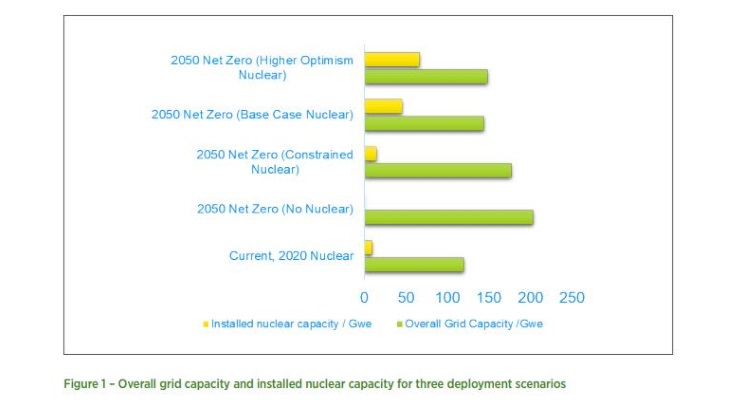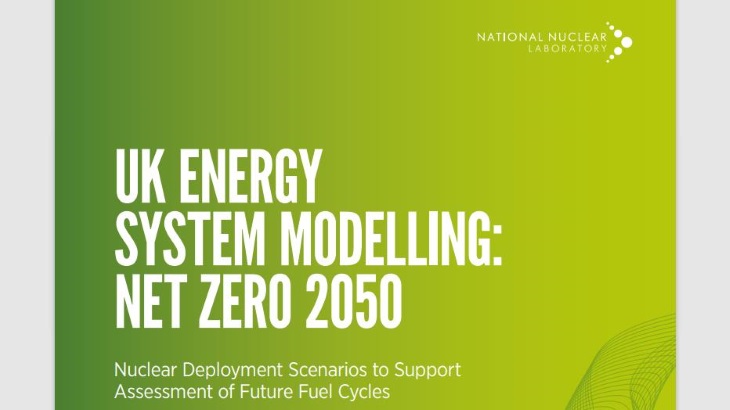The modelling, which was conducted with independent specialists from Energy Systems Catapult and LucidCatalyst, includes the role of nuclear in providing not only electricity but also heat, hydrogen and synthetic fuels. It adds to the national and international dataset that considers pathways to decarbonisation, and has already been used to underpin AFCP's net-zero roadmap, which will be published later this year.
"To enable the deep decarbonisation that is required to meet net zero, it is clear that we need to completely and utterly transform the totality of our energy system," Fiona Rayment, NNL's chief science and technology officer, said. "The challenge our sector needs to overcome is not technical, but economic; by co-generating zero-carbon electricity with a new supply of green hydrogen, fuels and heat, nuclear can make a vital, and commercially viable, contribution to the UK’s future energy mix."
The analysis shows that to meet net zero, the UK needs to vastly increase the production of three zero-carbon energy vectors - electricity, hydrogen and district heating, Scott Milne, head of insights at Energy Systems Catapult, said.
"The modelling explores the cost and performance parameters that would need to be achieved by a range of nuclear technologies in order to contribute - alongside renewables and carbon, capture & storage - to the rapid scale-up of those three energy vectors," he said. "Our analysis shows how nuclear can help to minimise the overall physical footprint of the energy system and contribute to achieving net zero at least cost to society."
Four scenarios
The report presents nuclear deployment scenarios in a 2050 net-zero UK energy mix using the whole energy system model known as Energy System Modelling Environment.
These are:
- Constrained by policy to a capped level (14 GWe) of nuclear deployment;
- Base case informed by a level of deployment consistent with a net zero whole energy system analysis which is optimised for minimum cost whilst being technology and policy neutral;
- Higher optimism reflecting lower nuclear costs and a more aggressive schedule for bringing advanced nuclear technologies to market; and
- Greater nuclear ambition with new technologies for low-cost high-volume hydrogen and synthetic fuel production included.

These scenarios are not intended to be "predictions of the future", the report says, but to look at a range of possible future roles for nuclear in a net-zero 2050 UK energy system. This enables "appropriate assessment" of potential fuel and fuel cycle technology needs to be considered and investigated, it says, adding that it is also "crucial to understand" potential future markets for future fuels.
Advanced fuel and fuel cycle technology research, development and demonstration roadmaps will be published (separately) based on the nuclear deployment scenarios outlined. In addition, detailed ORION fuel cycle modelling (using input data from this energy system modelling work) will be published to understand the potential implications of scenarios that may need to be considered from a UK strategic perspective.
Kirsty Gogan, managing director at LucidCatalyst, said: "This modelling presents valuable new insights for the UK’s net zero transition. These opportunities were either grossly under-represented in - or completely absent from - previous energy system modelling. Including their transformative potential offers a radical new perspective on our prospects for affordable and rapid decarbonisation."
Eric Ingersoll, also managing director at LucidCatalyst, added: "If we can produce clean drop-in substitute fuels at scale, this reduces the extent of transformation required. This is a major benefit in terms of lowering the overall investment, disruption and behaviour change required to maintain energy services. Essentially, this offers an opportunity to decouple energy from emissions without increasing cost or decreasing performance."
The report is here.





_18570.jpg)
_16159.jpg)
_18938.jpg)
_33584.jpg)





